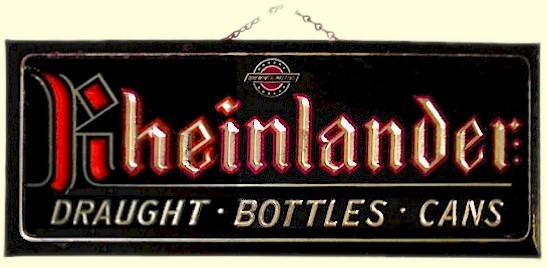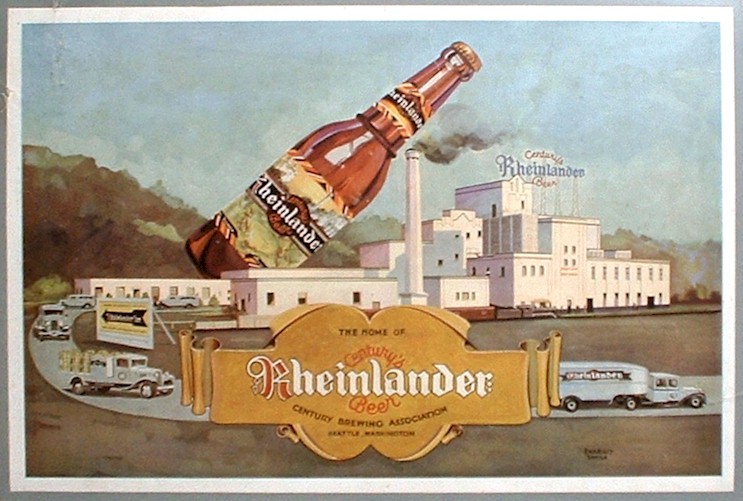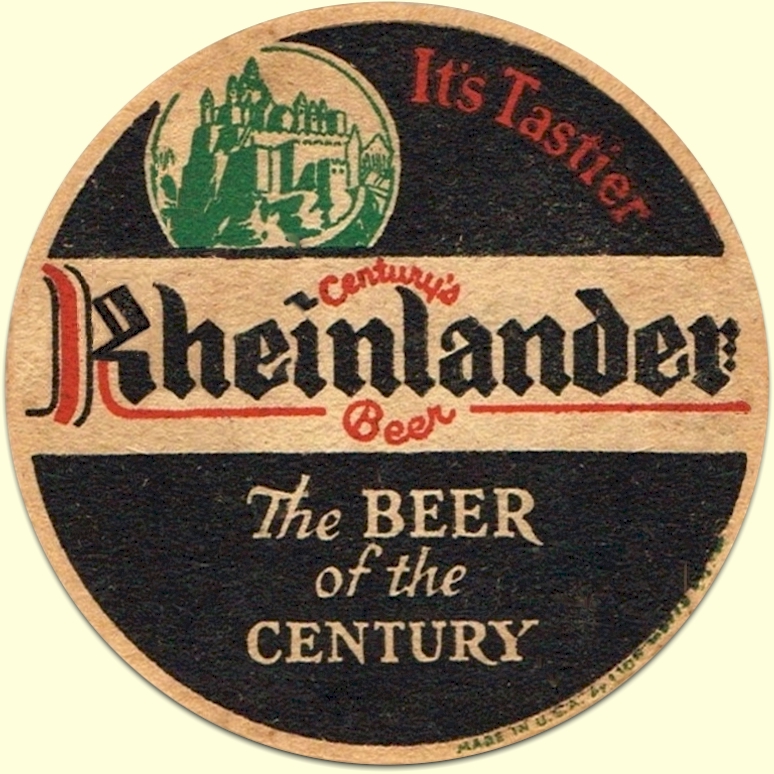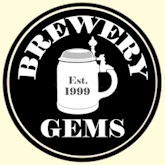|
Century Brewery Association
(1933-1935)
Collectors of NW Breweriana are familiar with the tagline:
"Rainier Beer...Since 1878",
but many would be surprised to learn that it wasn't until 1935 that the
brewery, on Seattle's Airport Way, brewed any Rainier Beer.
But first, there was Rheinlander.
With the end of Prohibition in 1933 the Century Brewing Assn. was established by a Canadian group headed by the Sick family to
purchase one of the closed breweries for entry into the Seattle market. The Bay View Brewery
had been closed by state-wide prohibition in 1915,
and in the 1920's it was converted into a feed mill. The company chose this building for
its plan to convert it to a state-of-the-art brewery.
In his 1958 memoirs, Emil Sick recalled:"In the summer of 1933, we commenced rebuilding.
All we kept of the old brewery actually were the walls, which we reinforced with concrete and steel. Our first cellars were all equipped with wooden tanks made by a cooperage in Vancouver, BC.
The brewing equipment was taken out of the defunct Crystal Brewing Co. in Regina, Saskatchewan, together with certain bottling machinery from the same and another closed brewery."
The exterior also had a major makeover. A 1934 trade journal article described the plant as:
"...striking in an exterior coating of silver-hued, aluminum paint, with navy-blue trim.
The article continued: Quite unique in the aggressive advertising campaign
launched to feature the company's entrance into the beer merchandising field, is the erection of the largest Kirsten high-intensity
Neon sign in the world atop the brewery, illuminating the words 'Century's Rheinlander Beer' in green and red. This huge sign contains in its superstructure 13 tons of steel. It is 97 feet long and 37 feet high."

In January of 1934, Rheinlander
Beer was released
in pre-prohibition full strength, after aging in wood for 90 days. The
brewery's brewmaster, Karl Heigenmooser, was born and trained in Munich,
Germany, and so his Rheinlander was a Muenchner-style lager - darker
than a Pilsener, with a touch of sweetness, and light on hops.
In
an effort to offer the most flavorful beer possible many breweries
offered unpasteurized Draught (draft) beer in half-gallon jugs. The
Century did the same but also came up with a novel option. In addition
to the half-gallon and quart offerings, they developed a carry
carton to hold three 22 oz. bottles of draught.
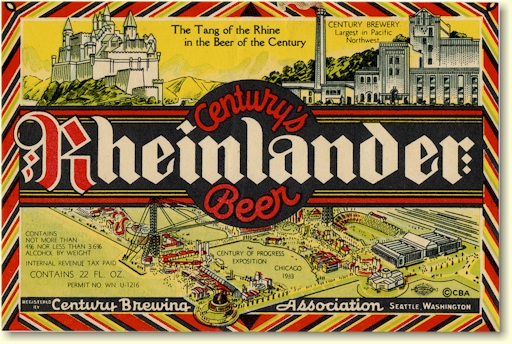 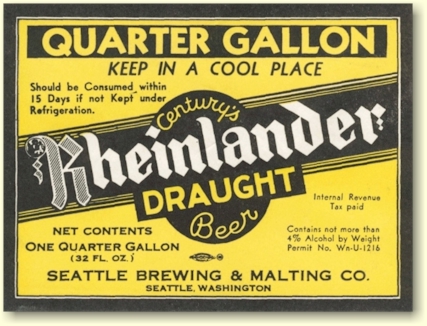
|
For the Christmas season Heigenmooser crafted a
Kulmbacher-type brew, which was even darker and heavier than his Munich-inspired brew, but was only produced for the 1934 and '35 seasons.
Another seasonal brew, produced in limited
quantities by most U.S. breweries of this period, was a Bock Beer. Oddly,
Rheinlander Bock was only produced once - for the 1935 Spring release.
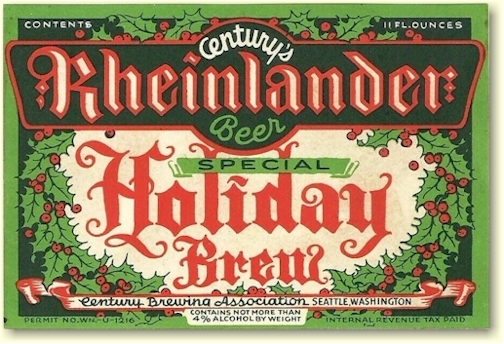 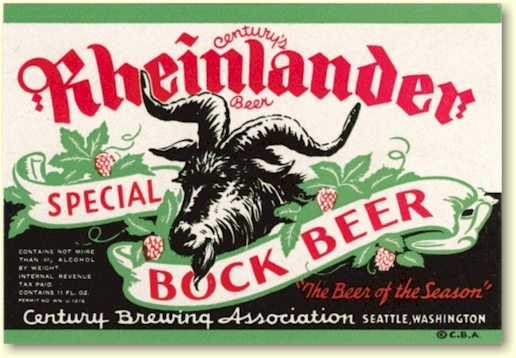
|
In July of 1935, a major development took place that changed the company.
When state-wide Prohibition hit Washington, brewers had to either
produce non-alcoholic beverages, move to a different state, or close
down. The Hemrich family, makers of the popular Rainier Beer, chose to
move to San Francisco and build a new brewery there. With the end of
Prohibition they were again supplying western states with Rainier Beer.
They also announced that they planned to reopen the Georgetown plant in Seattle - the pre-Prohibition
home of Rainier Beer.
To counter this threat, the Century Brewing Assn.
made a royalty deal with the
Rainier Brewing Co. which
allowed the use of the Rainier name for production and sales in
Washington and Alaska. The royalty was $.75/barrel with a $75K per year minimum. The Century Brewing Assn. name was then changed to Seattle
Brewing & Malting.

Seattle Brewing & Malting Company
(1935-1944)
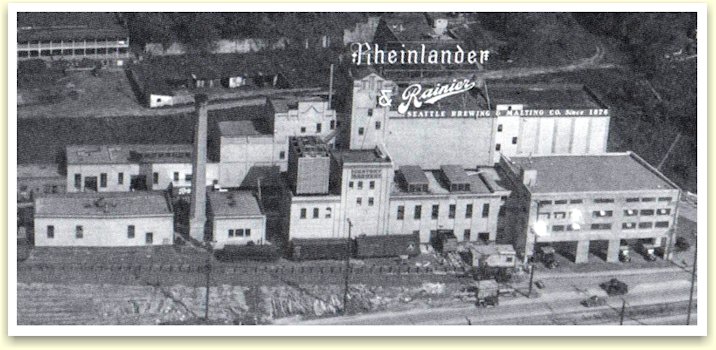
Century Brewery with new signage
The Century Brewery's brewmaster was now overseeing the production
of both Rheinlander and Rainier beers, and was about to undertake some new challenges.
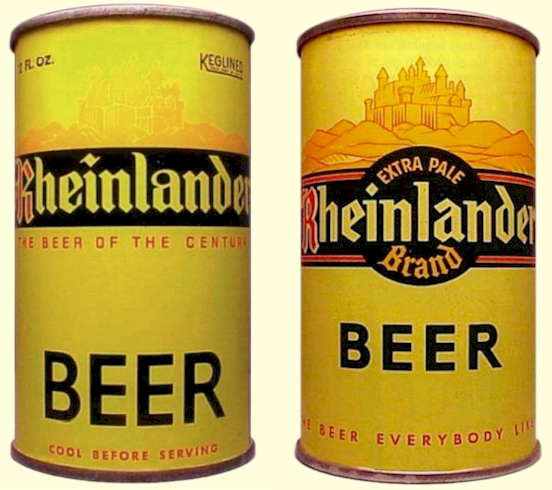
In mid-1936 canned beer became a reality
and the Brewery released its first canned Rheinlander before the
year was out. They also adopted the new "stubby" bottle.
This Munich-style Rheinlander may have paled in comparison to their
new Pilsener-style Rainier beer, since Heigenmooser was tasked with
formulating a new lighter style. His Extra Pale Rheinlander was
introduced in May of 1937, in both bottles and cans. The following
month Heigenmooser announced his retirement and left for Delaware
where, rather than retiring, he took another brewmaster position.
The following year saw further changes for the Rheinlander brand.
It
was to be moved to a new home.

Rheinlander Brewery,
Inc.
(1938-1939)
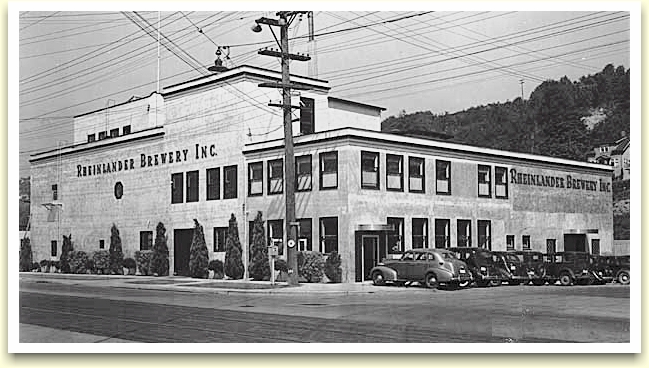
This plant on Airport Way was the previous home of the
Apex Brewing Co. Following the death of its
founder, Alvin Hemrich, and the death of
Elmer Hemrich, the family chose to sell the brewery.
In January of '38, Seattle Brewing & Malting Co. (called SeaBrew by insiders)
purchased the company.
However, SeaBrew planned to use the plant solely for the production of their Rheinlander beer and did not
continue with the "Apex" brand. The adjacent Century plant would then
focus solely on the production of the recently acquired Rainier brand.
One noticeable change in their branding was dropping the Germanic font on the labels and promotional material. Even their canned Rheinlander Pale Export had a changed font.
By July of 1938, the plant at 2918 Airport Way was producing
both Rheinlander Beer, and Rheinlander Ale. The beer and ale
was brewed here, but bottled in the nearby main plant. To
set Rheinlander apart from other beer and ales they claimed their
brews were enriched with valuable malt-yeast vitamins B & G.
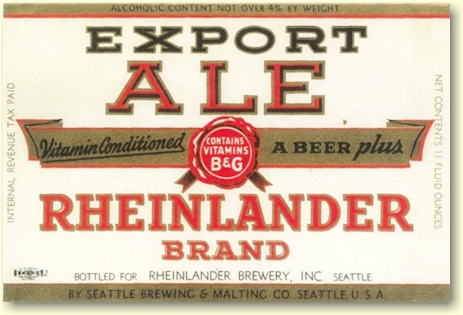
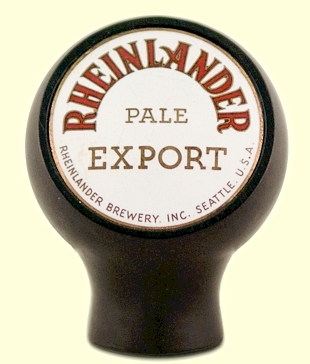
Production at this location was to last but one year. In May of
1939, the
Horluck's Brewery
had been purchased by the Sicks' enterprise, and undergone an
extensive remodel. In October of '39, the Horluck plant was to
become the new home of Rheinander Beer.

The Century Brewery
(1939-1941)
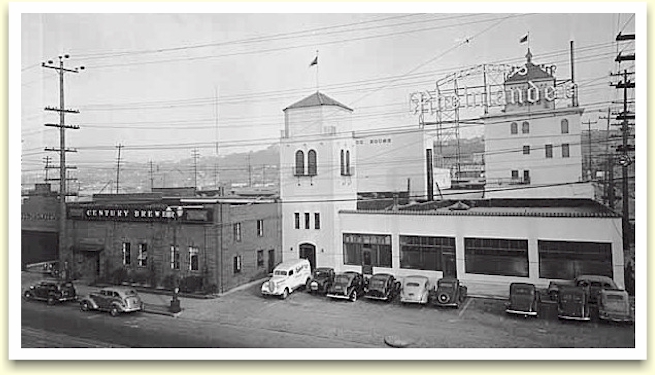
With Rheinlander's new home in the old Horluck plant came the appropriate signage that read "Century's Rheinlander" with the "Rheinlander"
portion sourced from the sign previously atop the main plant.
With production now in the new Century Brewery, the labels were unchanged except for Seattle Brewing and Malting identified as the producer rather than Century Brewery
- but not so for the tap knob.
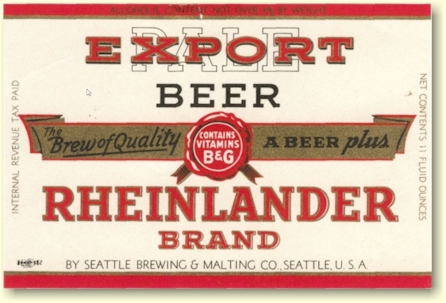
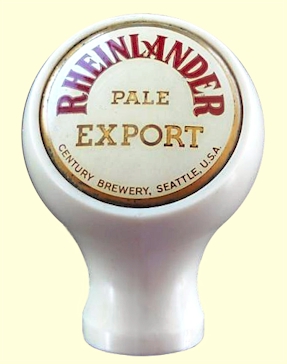
By April of 1940, a new label was designed and the Vitamin B & G claim was dropped.
Oddly, the new look wasn't given to the canned
Rheinlander as can be seen on the sign below. This
makeover may not have done much to increase sales as
the brand was struggling. In September of 1941,
Rheinlander was discontinued and the Century Brewery
was now the home of Sick's Select Beer.
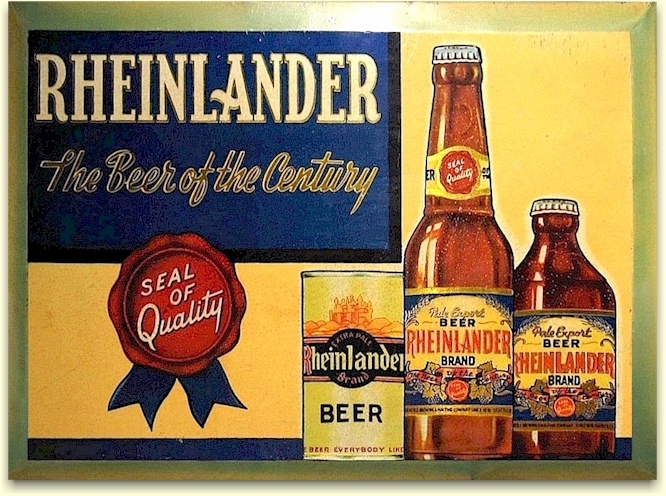
This essentially closes the Rheinlander chapter. However, 20 years
later the brand was resurrected and hung on until 1992.

Sicks' Rainier Brewing Co.
and successor
Rainier Brewing Co.
In 1961, Sicks' Rainier Brewing Co.
had Rainier Beer as their flag-ship brand, but not much else. Sicks'
Select had been replaced by Brew 66, and that was now only offered
on draft. They needed a budget brand for the grocery store trade so
they reintroduced Rheinlander Beer - and added Highlander Beer as
well. The company then established two divisions, the Rheinlander
Brg. Co. and the Highland Brg. Co., to act as brand managers. Yet
both divisions distributed each other's products as well as their
own - which I don't understand.
The
1961 Rheinlander Beer can had a steel top, one version lists the producer as the Highlander Brewing Co., while others list the Rheinlander Brewing Co.
This version was soon followed
by an aluminum "soft top" that made piercing easier. In '63, the cans were fitted with an aluminum "tab top" or "zip top."
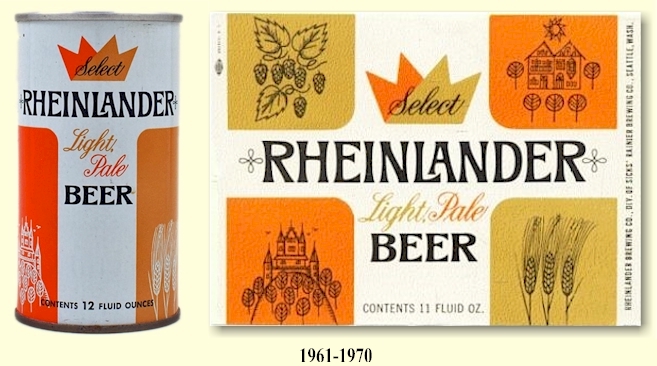
In 1970, they were still using the steel can with the zip-top lid, but with a new design. This was soon followed by an all-aluminum version.
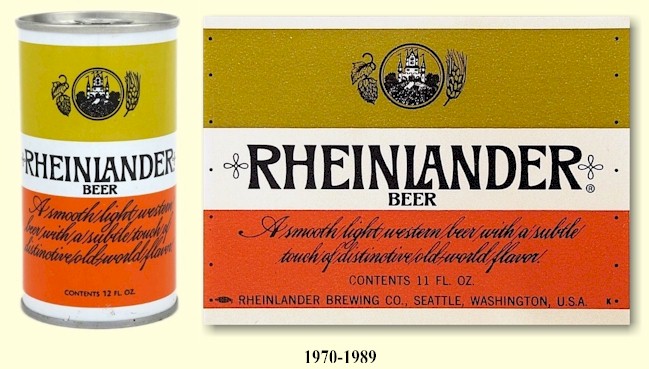
Finally, in 1989 another newly designed can was introduced. The brand was to last another five years until it was
terminated in '92.
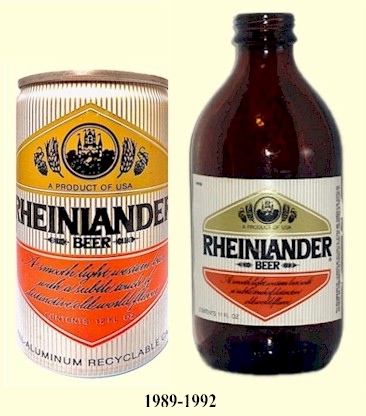

Rheinlander Breweriana
|
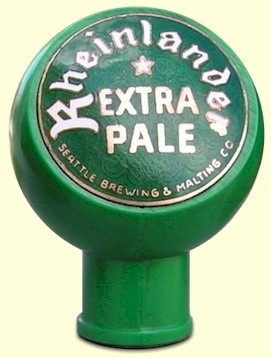 |


